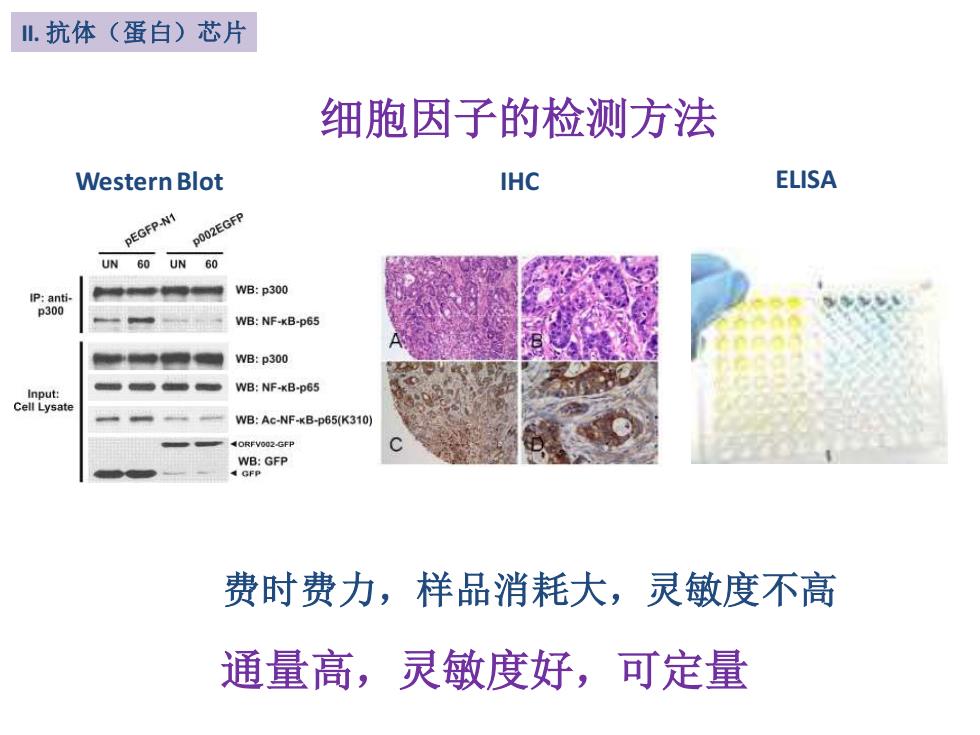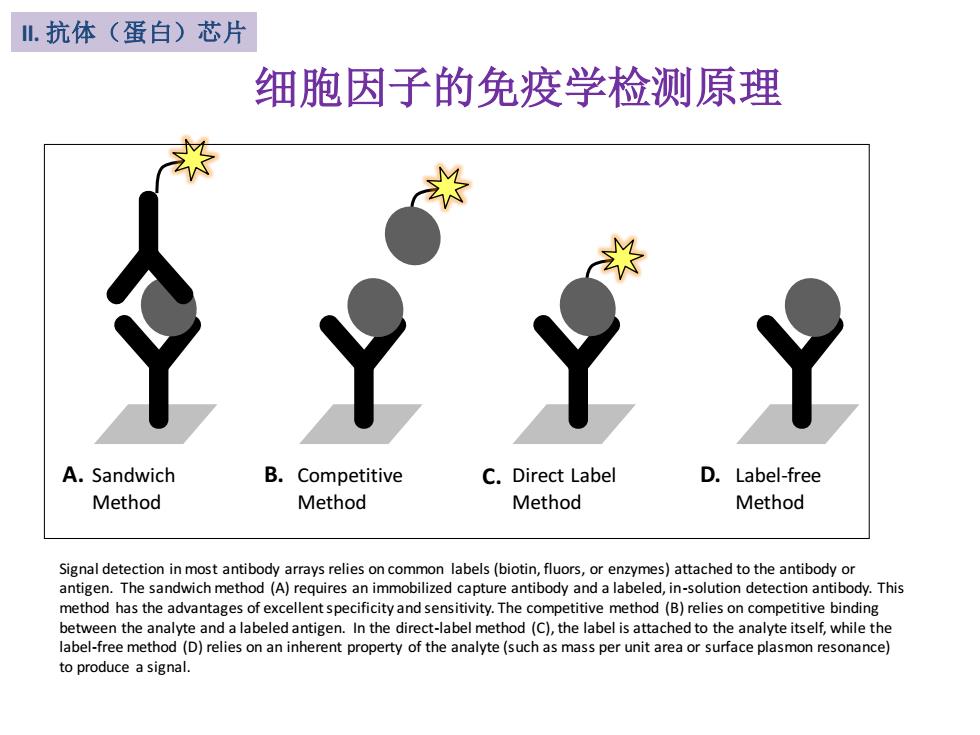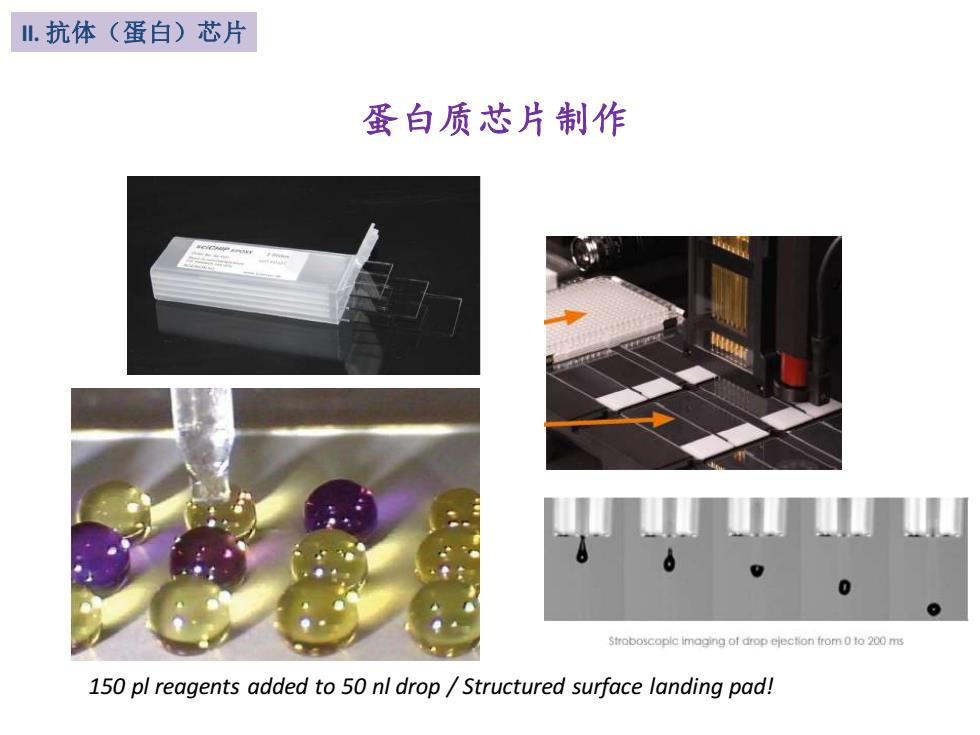
1.抗体(蛋白)芯片 细胞因子的重要性 正常的生理过程 细胞因子在疾病中的影响 Inflammation 一癌症 ·Tumorigenesis, Metastasis Immune response ·Angiogenesis Cell migration tissue Invasion,proliferation infiltration 自身免疫疾病 Angiogenesis Rheumatoid arthritis Adipogenesis ·Psoriasis Apoptosis ·Multiple sclerosis 细胞因子种类多,功能复杂,而且含量少!
细胞因子的重要性 • 正常的生理过程 – Inflammation – Immune response – Cell migration & tissue infiltration – Angiogenesis – Adipogenesis – Apoptosis – Wound healing – Immune cell maturation – Hematopoiesis – Cells Growth, proliferation, and differentiation • 细胞因子在疾病中的影响 – 癌症 • Tumorigenesis, Metastasis • Angiogenesis • Invasion, proliferation – 自身免疫疾病 • Rheumatoid arthritis • Psoriasis • Multiple sclerosis • Systemic lupus erythematosus – 神经退行性疾病 • Alzheimer’s • Parkinson’s • Atherosclerosis – 心血管疾病 II. 抗体(蛋白)芯片 细胞因子种类多,功能复杂,而且含量少!

Ⅱ.抗体(蛋白)芯片 细胞因子的检测方法 Western Blot IHC ELISA pEGFP-N1 p002EGFP UN 60 UN 60 WB:p300 IP:anti- p300 WB:NF-xB-p65 WB:p300 Input: WB:NF-xB-p65 Cell Lysate WB:Ac-NF-KB-p65(K310) 4ORFV002-GFP WB:GFP 4 GFP 费时费力,样品消耗大,灵敏度不高 通量高,灵敏度好,可定量
细胞因子的检测方法 Western Blot 费时费力,样品消耗大,灵敏度不高 IHC ELISA II. 抗体(蛋白)芯片 通量高,灵敏度好,可定量

1.抗体(蛋白)芯片 细胞因子的免疫学检测原理 A.Sandwich B.Competitive C.Direct Label D.Label-free Method Method Method Method Signal detection in most antibody arrays relies on common labels(biotin,fluors,or enzymes)attached to the antibody or antigen.The sandwich method(A)requires an immobilized capture antibody and a labeled,in-solution detection antibody.This method has the advantages of excellent specificity and sensitivity.The competitive method(B)relies on competitive binding between the analyte and a labeled antigen.In the direct-label method(C),the label is attached to the analyte itself,while the label-free method(D)relies on an inherent property of the analyte(such as mass per unit area or surface plasmon resonance) to produce a signal
Sandwich Method Direct Label Method Competitive Method Label-free Method A. B. C. D. Signal detection in most antibody arrays relies on common labels (biotin, fluors, or enzymes) attached to the antibody or antigen. The sandwich method (A) requires an immobilized capture antibody and a labeled, in-solution detection antibody. This method has the advantages of excellent specificity and sensitivity. The competitive method (B) relies on competitive binding between the analyte and a labeled antigen. In the direct-label method (C), the label is attached to the analyte itself, while the label-free method (D) relies on an inherent property of the analyte (such as mass per unit area or surface plasmon resonance) to produce a signal. 细胞因子的免疫学检测原理 II. 抗体(蛋白)芯片

山.抗体(蛋白)芯片 -一抗体(蛋白质)芯片:将大量不同的抗体(蛋白质)有序 地排列、固定于固相载体表面,形成微阵列。利用蛋白质分 子间特异性结合的原理,实现对生物蛋白质分子精准、快速、 高通量的检测
- 抗体(蛋白质)芯片: 将大量不同的抗体(蛋白质)有序 地排列、固定于固相载体表面,形成微阵列。利用蛋白质分 子间特异性结合的原理,实现对生物蛋白质分子精准、快速、 高通量的检测。 II. 抗体(蛋白)芯片

1.抗体(蛋白)芯片 蛋白质芯片制作 0 Stroboscopic imaging ot drop election trom 0 to 200 ms 150 pl reagents added to 50 nl drop Structured surface landing pad!
蛋白质芯片制作 150 pl reagents added to 50 nl drop / Structured surface landing pad! II. 抗体(蛋白)芯片